Power Quality and Energy Router: Renewable Energy Integration Analysis
VerifiedAdded on 2022/11/11
|37
|9008
|358
Project
AI Summary
This project investigates the advancements in power quality related to the integration of renewable energy sources into power grids, focusing on the application of Internet Energy. The study examines the benefits of this technology, including improved power stability and system security, and its ability to monitor and control the switching of renewable energy sources. The report includes a literature review on the challenges of integrating renewable energy, such as wind and solar, into the grid, and discusses the application of smart grid technologies, fuel cells, and electric vehicles. A case study using Simulink simulates the energy router's architecture and its control of distributed generation, including electric vehicles, battery energy storage, and PV systems. The results demonstrate the energy router's ability to manage reactive power and the charging of EVs, contributing to enhanced grid performance. The conclusion emphasizes the importance of this technology for addressing global warming issues and future work will include more research on the LAN-level energy control router.
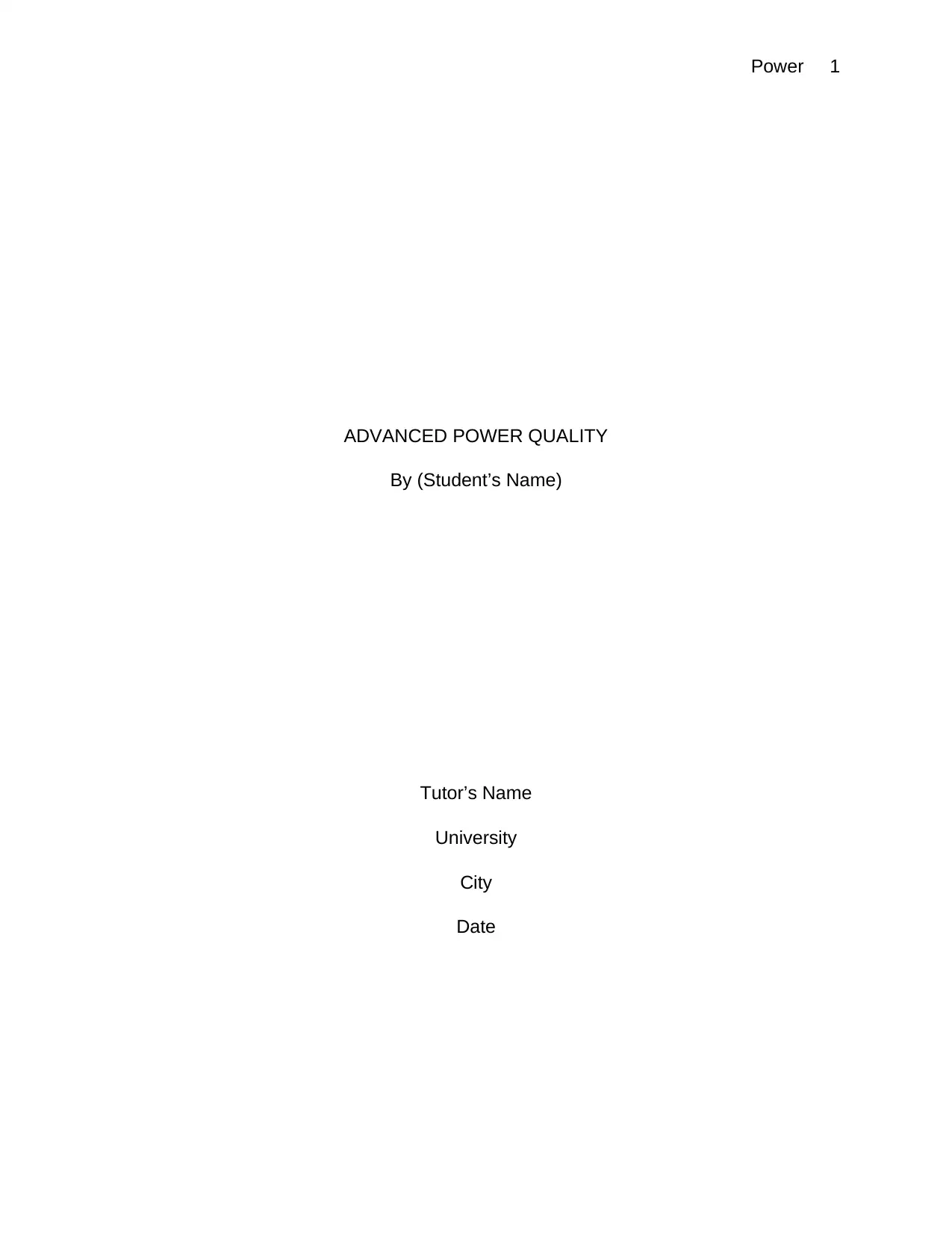
Power 1
ADVANCED POWER QUALITY
By (Student’s Name)
Tutor’s Name
University
City
Date
ADVANCED POWER QUALITY
By (Student’s Name)
Tutor’s Name
University
City
Date
Paraphrase This Document
Need a fresh take? Get an instant paraphrase of this document with our AI Paraphraser
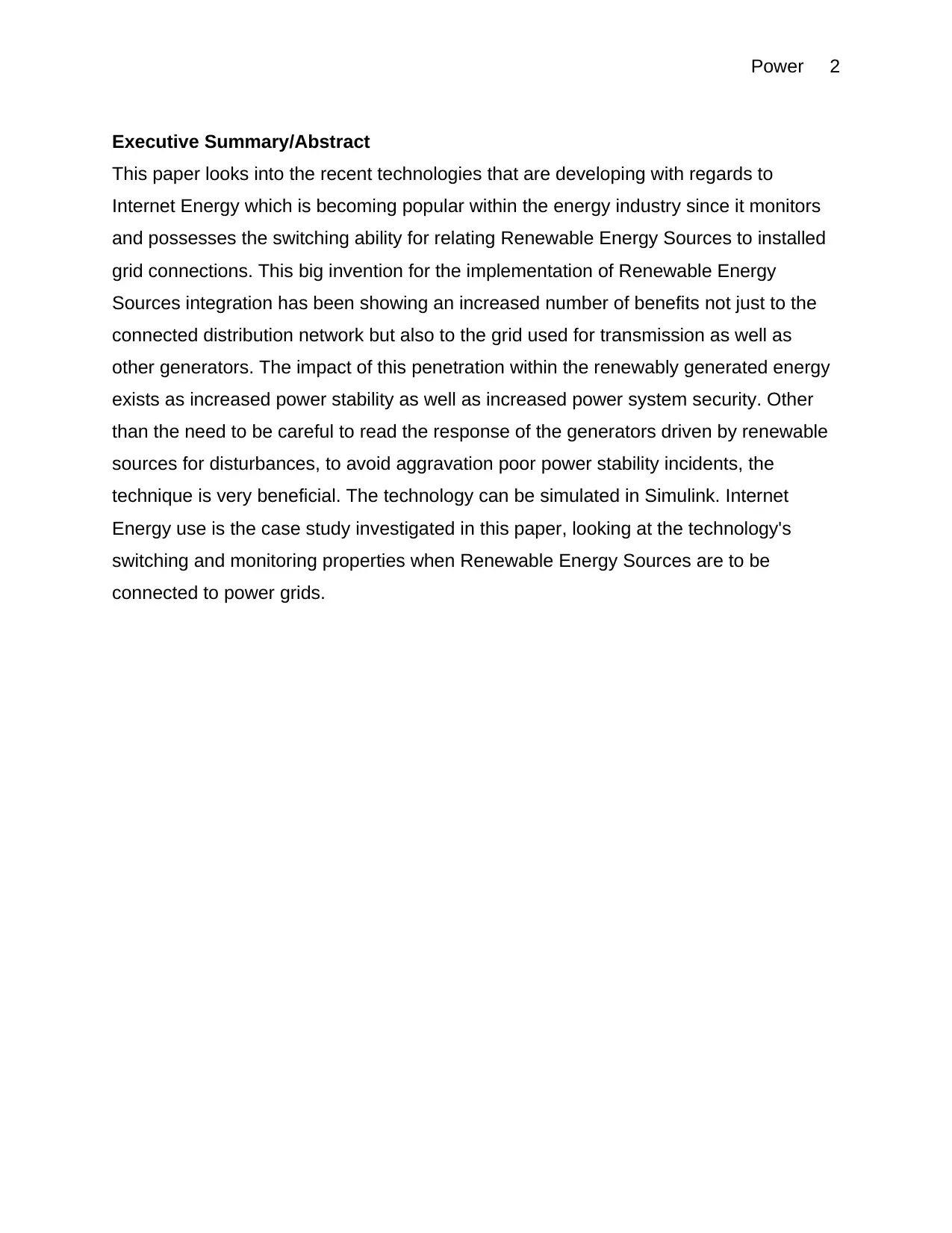
Power 2
Executive Summary/Abstract
This paper looks into the recent technologies that are developing with regards to
Internet Energy which is becoming popular within the energy industry since it monitors
and possesses the switching ability for relating Renewable Energy Sources to installed
grid connections. This big invention for the implementation of Renewable Energy
Sources integration has been showing an increased number of benefits not just to the
connected distribution network but also to the grid used for transmission as well as
other generators. The impact of this penetration within the renewably generated energy
exists as increased power stability as well as increased power system security. Other
than the need to be careful to read the response of the generators driven by renewable
sources for disturbances, to avoid aggravation poor power stability incidents, the
technique is very beneficial. The technology can be simulated in Simulink. Internet
Energy use is the case study investigated in this paper, looking at the technology's
switching and monitoring properties when Renewable Energy Sources are to be
connected to power grids.
Executive Summary/Abstract
This paper looks into the recent technologies that are developing with regards to
Internet Energy which is becoming popular within the energy industry since it monitors
and possesses the switching ability for relating Renewable Energy Sources to installed
grid connections. This big invention for the implementation of Renewable Energy
Sources integration has been showing an increased number of benefits not just to the
connected distribution network but also to the grid used for transmission as well as
other generators. The impact of this penetration within the renewably generated energy
exists as increased power stability as well as increased power system security. Other
than the need to be careful to read the response of the generators driven by renewable
sources for disturbances, to avoid aggravation poor power stability incidents, the
technique is very beneficial. The technology can be simulated in Simulink. Internet
Energy use is the case study investigated in this paper, looking at the technology's
switching and monitoring properties when Renewable Energy Sources are to be
connected to power grids.

Power 3
Acknowledgement
This report’s successful completion brings happiness and enlightenment within the topic
of study given that the tutor was welcoming and helpful in its completion. Their advice
and support both in notes provision and giving direction helped me carry out this
research.
Acknowledgement
This report’s successful completion brings happiness and enlightenment within the topic
of study given that the tutor was welcoming and helpful in its completion. Their advice
and support both in notes provision and giving direction helped me carry out this
research.
⊘ This is a preview!⊘
Do you want full access?
Subscribe today to unlock all pages.

Trusted by 1+ million students worldwide
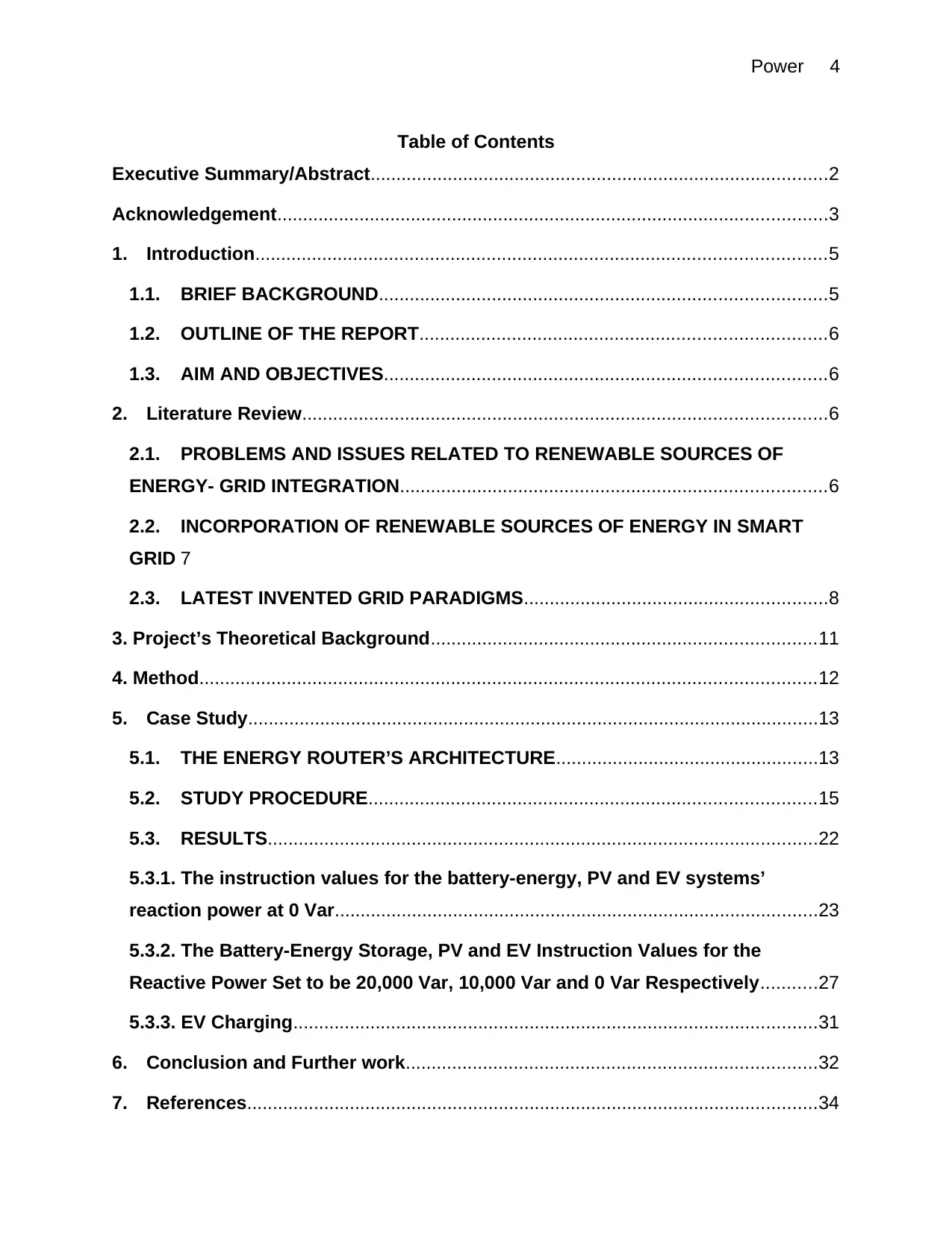
Power 4
Table of Contents
Executive Summary/Abstract.........................................................................................2
Acknowledgement...........................................................................................................3
1. Introduction...............................................................................................................5
1.1. BRIEF BACKGROUND.......................................................................................5
1.2. OUTLINE OF THE REPORT...............................................................................6
1.3. AIM AND OBJECTIVES......................................................................................6
2. Literature Review......................................................................................................6
2.1. PROBLEMS AND ISSUES RELATED TO RENEWABLE SOURCES OF
ENERGY- GRID INTEGRATION...................................................................................6
2.2. INCORPORATION OF RENEWABLE SOURCES OF ENERGY IN SMART
GRID 7
2.3. LATEST INVENTED GRID PARADIGMS...........................................................8
3. Project’s Theoretical Background...........................................................................11
4. Method........................................................................................................................12
5. Case Study...............................................................................................................13
5.1. THE ENERGY ROUTER’S ARCHITECTURE...................................................13
5.2. STUDY PROCEDURE.......................................................................................15
5.3. RESULTS...........................................................................................................22
5.3.1. The instruction values for the battery-energy, PV and EV systems’
reaction power at 0 Var..............................................................................................23
5.3.2. The Battery-Energy Storage, PV and EV Instruction Values for the
Reactive Power Set to be 20,000 Var, 10,000 Var and 0 Var Respectively...........27
5.3.3. EV Charging......................................................................................................31
6. Conclusion and Further work................................................................................32
7. References...............................................................................................................34
Table of Contents
Executive Summary/Abstract.........................................................................................2
Acknowledgement...........................................................................................................3
1. Introduction...............................................................................................................5
1.1. BRIEF BACKGROUND.......................................................................................5
1.2. OUTLINE OF THE REPORT...............................................................................6
1.3. AIM AND OBJECTIVES......................................................................................6
2. Literature Review......................................................................................................6
2.1. PROBLEMS AND ISSUES RELATED TO RENEWABLE SOURCES OF
ENERGY- GRID INTEGRATION...................................................................................6
2.2. INCORPORATION OF RENEWABLE SOURCES OF ENERGY IN SMART
GRID 7
2.3. LATEST INVENTED GRID PARADIGMS...........................................................8
3. Project’s Theoretical Background...........................................................................11
4. Method........................................................................................................................12
5. Case Study...............................................................................................................13
5.1. THE ENERGY ROUTER’S ARCHITECTURE...................................................13
5.2. STUDY PROCEDURE.......................................................................................15
5.3. RESULTS...........................................................................................................22
5.3.1. The instruction values for the battery-energy, PV and EV systems’
reaction power at 0 Var..............................................................................................23
5.3.2. The Battery-Energy Storage, PV and EV Instruction Values for the
Reactive Power Set to be 20,000 Var, 10,000 Var and 0 Var Respectively...........27
5.3.3. EV Charging......................................................................................................31
6. Conclusion and Further work................................................................................32
7. References...............................................................................................................34
Paraphrase This Document
Need a fresh take? Get an instant paraphrase of this document with our AI Paraphraser
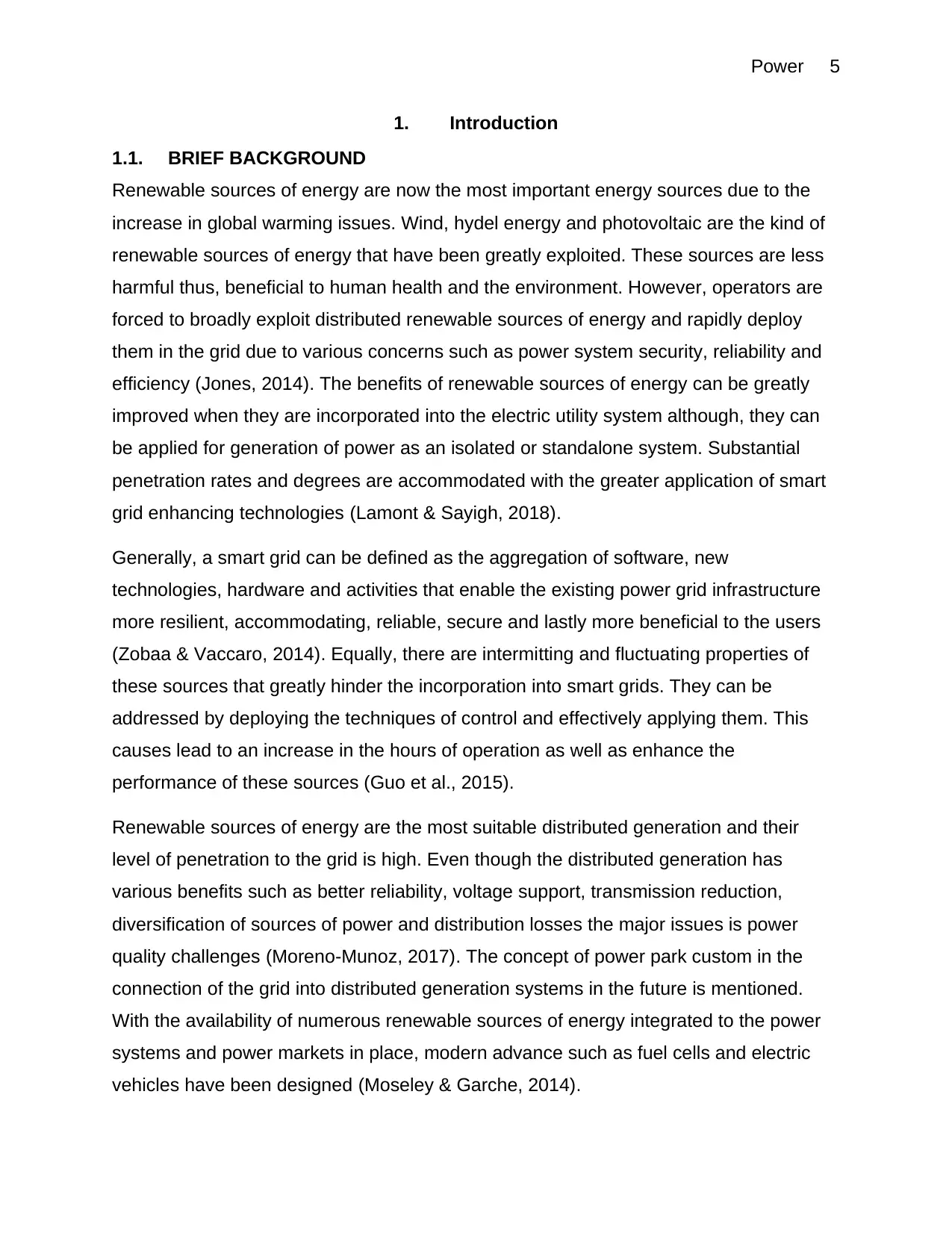
Power 5
1. Introduction
1.1. BRIEF BACKGROUND
Renewable sources of energy are now the most important energy sources due to the
increase in global warming issues. Wind, hydel energy and photovoltaic are the kind of
renewable sources of energy that have been greatly exploited. These sources are less
harmful thus, beneficial to human health and the environment. However, operators are
forced to broadly exploit distributed renewable sources of energy and rapidly deploy
them in the grid due to various concerns such as power system security, reliability and
efficiency (Jones, 2014). The benefits of renewable sources of energy can be greatly
improved when they are incorporated into the electric utility system although, they can
be applied for generation of power as an isolated or standalone system. Substantial
penetration rates and degrees are accommodated with the greater application of smart
grid enhancing technologies (Lamont & Sayigh, 2018).
Generally, a smart grid can be defined as the aggregation of software, new
technologies, hardware and activities that enable the existing power grid infrastructure
more resilient, accommodating, reliable, secure and lastly more beneficial to the users
(Zobaa & Vaccaro, 2014). Equally, there are intermitting and fluctuating properties of
these sources that greatly hinder the incorporation into smart grids. They can be
addressed by deploying the techniques of control and effectively applying them. This
causes lead to an increase in the hours of operation as well as enhance the
performance of these sources (Guo et al., 2015).
Renewable sources of energy are the most suitable distributed generation and their
level of penetration to the grid is high. Even though the distributed generation has
various benefits such as better reliability, voltage support, transmission reduction,
diversification of sources of power and distribution losses the major issues is power
quality challenges (Moreno-Munoz, 2017). The concept of power park custom in the
connection of the grid into distributed generation systems in the future is mentioned.
With the availability of numerous renewable sources of energy integrated to the power
systems and power markets in place, modern advance such as fuel cells and electric
vehicles have been designed (Moseley & Garche, 2014).
1. Introduction
1.1. BRIEF BACKGROUND
Renewable sources of energy are now the most important energy sources due to the
increase in global warming issues. Wind, hydel energy and photovoltaic are the kind of
renewable sources of energy that have been greatly exploited. These sources are less
harmful thus, beneficial to human health and the environment. However, operators are
forced to broadly exploit distributed renewable sources of energy and rapidly deploy
them in the grid due to various concerns such as power system security, reliability and
efficiency (Jones, 2014). The benefits of renewable sources of energy can be greatly
improved when they are incorporated into the electric utility system although, they can
be applied for generation of power as an isolated or standalone system. Substantial
penetration rates and degrees are accommodated with the greater application of smart
grid enhancing technologies (Lamont & Sayigh, 2018).
Generally, a smart grid can be defined as the aggregation of software, new
technologies, hardware and activities that enable the existing power grid infrastructure
more resilient, accommodating, reliable, secure and lastly more beneficial to the users
(Zobaa & Vaccaro, 2014). Equally, there are intermitting and fluctuating properties of
these sources that greatly hinder the incorporation into smart grids. They can be
addressed by deploying the techniques of control and effectively applying them. This
causes lead to an increase in the hours of operation as well as enhance the
performance of these sources (Guo et al., 2015).
Renewable sources of energy are the most suitable distributed generation and their
level of penetration to the grid is high. Even though the distributed generation has
various benefits such as better reliability, voltage support, transmission reduction,
diversification of sources of power and distribution losses the major issues is power
quality challenges (Moreno-Munoz, 2017). The concept of power park custom in the
connection of the grid into distributed generation systems in the future is mentioned.
With the availability of numerous renewable sources of energy integrated to the power
systems and power markets in place, modern advance such as fuel cells and electric
vehicles have been designed (Moseley & Garche, 2014).
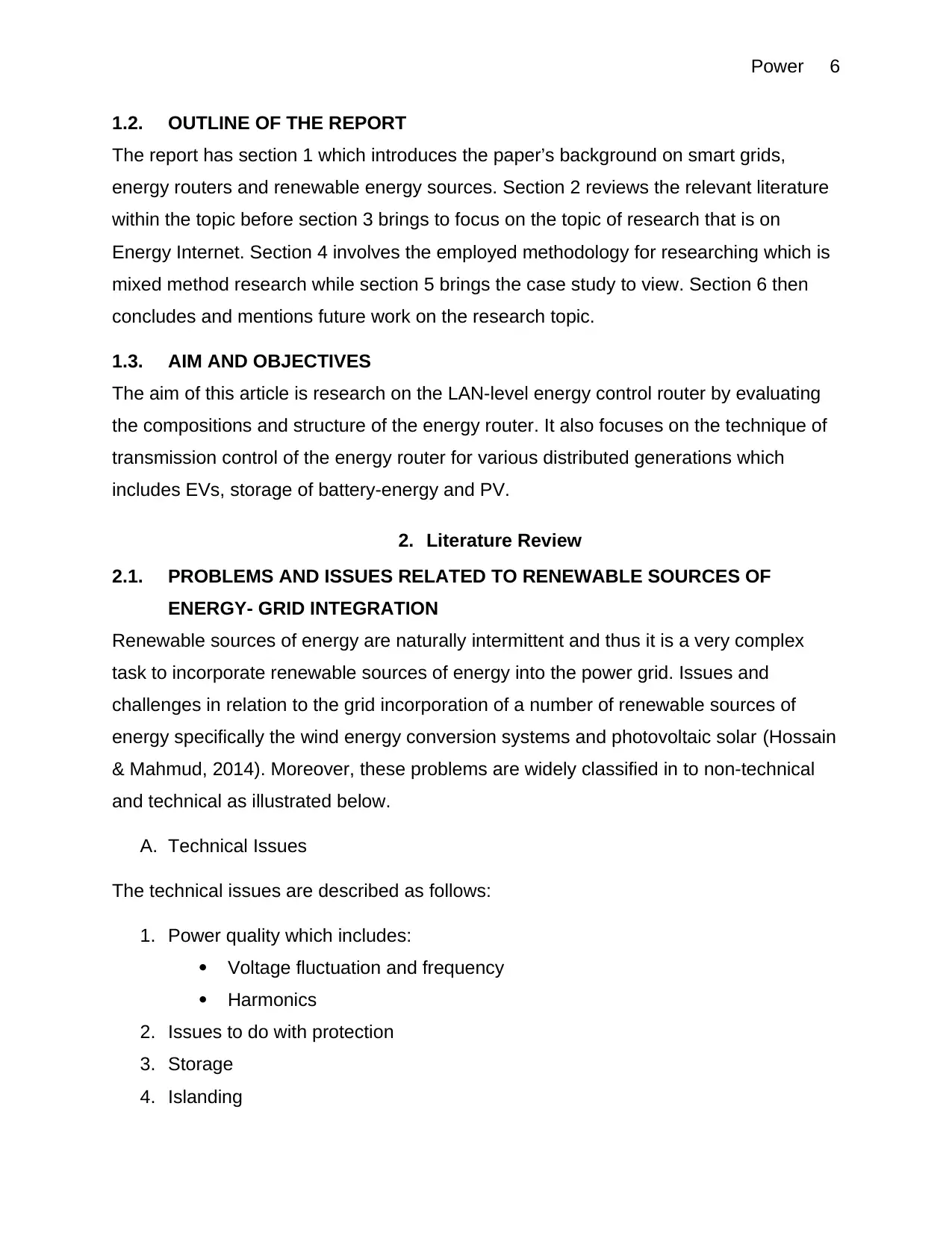
Power 6
1.2. OUTLINE OF THE REPORT
The report has section 1 which introduces the paper’s background on smart grids,
energy routers and renewable energy sources. Section 2 reviews the relevant literature
within the topic before section 3 brings to focus on the topic of research that is on
Energy Internet. Section 4 involves the employed methodology for researching which is
mixed method research while section 5 brings the case study to view. Section 6 then
concludes and mentions future work on the research topic.
1.3. AIM AND OBJECTIVES
The aim of this article is research on the LAN-level energy control router by evaluating
the compositions and structure of the energy router. It also focuses on the technique of
transmission control of the energy router for various distributed generations which
includes EVs, storage of battery-energy and PV.
2. Literature Review
2.1. PROBLEMS AND ISSUES RELATED TO RENEWABLE SOURCES OF
ENERGY- GRID INTEGRATION
Renewable sources of energy are naturally intermittent and thus it is a very complex
task to incorporate renewable sources of energy into the power grid. Issues and
challenges in relation to the grid incorporation of a number of renewable sources of
energy specifically the wind energy conversion systems and photovoltaic solar (Hossain
& Mahmud, 2014). Moreover, these problems are widely classified in to non-technical
and technical as illustrated below.
A. Technical Issues
The technical issues are described as follows:
1. Power quality which includes:
Voltage fluctuation and frequency
Harmonics
2. Issues to do with protection
3. Storage
4. Islanding
1.2. OUTLINE OF THE REPORT
The report has section 1 which introduces the paper’s background on smart grids,
energy routers and renewable energy sources. Section 2 reviews the relevant literature
within the topic before section 3 brings to focus on the topic of research that is on
Energy Internet. Section 4 involves the employed methodology for researching which is
mixed method research while section 5 brings the case study to view. Section 6 then
concludes and mentions future work on the research topic.
1.3. AIM AND OBJECTIVES
The aim of this article is research on the LAN-level energy control router by evaluating
the compositions and structure of the energy router. It also focuses on the technique of
transmission control of the energy router for various distributed generations which
includes EVs, storage of battery-energy and PV.
2. Literature Review
2.1. PROBLEMS AND ISSUES RELATED TO RENEWABLE SOURCES OF
ENERGY- GRID INTEGRATION
Renewable sources of energy are naturally intermittent and thus it is a very complex
task to incorporate renewable sources of energy into the power grid. Issues and
challenges in relation to the grid incorporation of a number of renewable sources of
energy specifically the wind energy conversion systems and photovoltaic solar (Hossain
& Mahmud, 2014). Moreover, these problems are widely classified in to non-technical
and technical as illustrated below.
A. Technical Issues
The technical issues are described as follows:
1. Power quality which includes:
Voltage fluctuation and frequency
Harmonics
2. Issues to do with protection
3. Storage
4. Islanding
⊘ This is a preview!⊘
Do you want full access?
Subscribe today to unlock all pages.

Trusted by 1+ million students worldwide
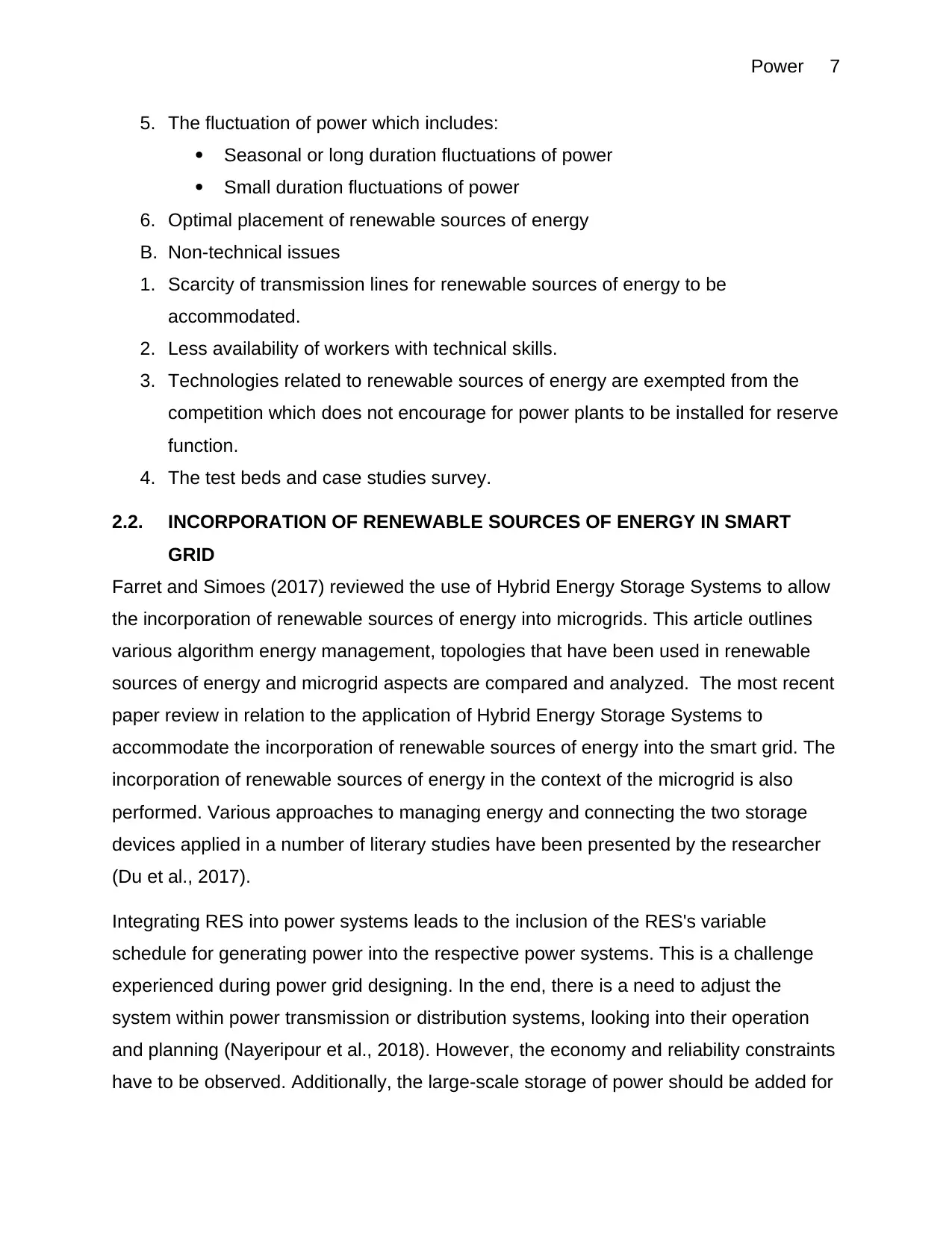
Power 7
5. The fluctuation of power which includes:
Seasonal or long duration fluctuations of power
Small duration fluctuations of power
6. Optimal placement of renewable sources of energy
B. Non-technical issues
1. Scarcity of transmission lines for renewable sources of energy to be
accommodated.
2. Less availability of workers with technical skills.
3. Technologies related to renewable sources of energy are exempted from the
competition which does not encourage for power plants to be installed for reserve
function.
4. The test beds and case studies survey.
2.2. INCORPORATION OF RENEWABLE SOURCES OF ENERGY IN SMART
GRID
Farret and Simoes (2017) reviewed the use of Hybrid Energy Storage Systems to allow
the incorporation of renewable sources of energy into microgrids. This article outlines
various algorithm energy management, topologies that have been used in renewable
sources of energy and microgrid aspects are compared and analyzed. The most recent
paper review in relation to the application of Hybrid Energy Storage Systems to
accommodate the incorporation of renewable sources of energy into the smart grid. The
incorporation of renewable sources of energy in the context of the microgrid is also
performed. Various approaches to managing energy and connecting the two storage
devices applied in a number of literary studies have been presented by the researcher
(Du et al., 2017).
Integrating RES into power systems leads to the inclusion of the RES's variable
schedule for generating power into the respective power systems. This is a challenge
experienced during power grid designing. In the end, there is a need to adjust the
system within power transmission or distribution systems, looking into their operation
and planning (Nayeripour et al., 2018). However, the economy and reliability constraints
have to be observed. Additionally, the large-scale storage of power should be added for
5. The fluctuation of power which includes:
Seasonal or long duration fluctuations of power
Small duration fluctuations of power
6. Optimal placement of renewable sources of energy
B. Non-technical issues
1. Scarcity of transmission lines for renewable sources of energy to be
accommodated.
2. Less availability of workers with technical skills.
3. Technologies related to renewable sources of energy are exempted from the
competition which does not encourage for power plants to be installed for reserve
function.
4. The test beds and case studies survey.
2.2. INCORPORATION OF RENEWABLE SOURCES OF ENERGY IN SMART
GRID
Farret and Simoes (2017) reviewed the use of Hybrid Energy Storage Systems to allow
the incorporation of renewable sources of energy into microgrids. This article outlines
various algorithm energy management, topologies that have been used in renewable
sources of energy and microgrid aspects are compared and analyzed. The most recent
paper review in relation to the application of Hybrid Energy Storage Systems to
accommodate the incorporation of renewable sources of energy into the smart grid. The
incorporation of renewable sources of energy in the context of the microgrid is also
performed. Various approaches to managing energy and connecting the two storage
devices applied in a number of literary studies have been presented by the researcher
(Du et al., 2017).
Integrating RES into power systems leads to the inclusion of the RES's variable
schedule for generating power into the respective power systems. This is a challenge
experienced during power grid designing. In the end, there is a need to adjust the
system within power transmission or distribution systems, looking into their operation
and planning (Nayeripour et al., 2018). However, the economy and reliability constraints
have to be observed. Additionally, the large-scale storage of power should be added for
Paraphrase This Document
Need a fresh take? Get an instant paraphrase of this document with our AI Paraphraser
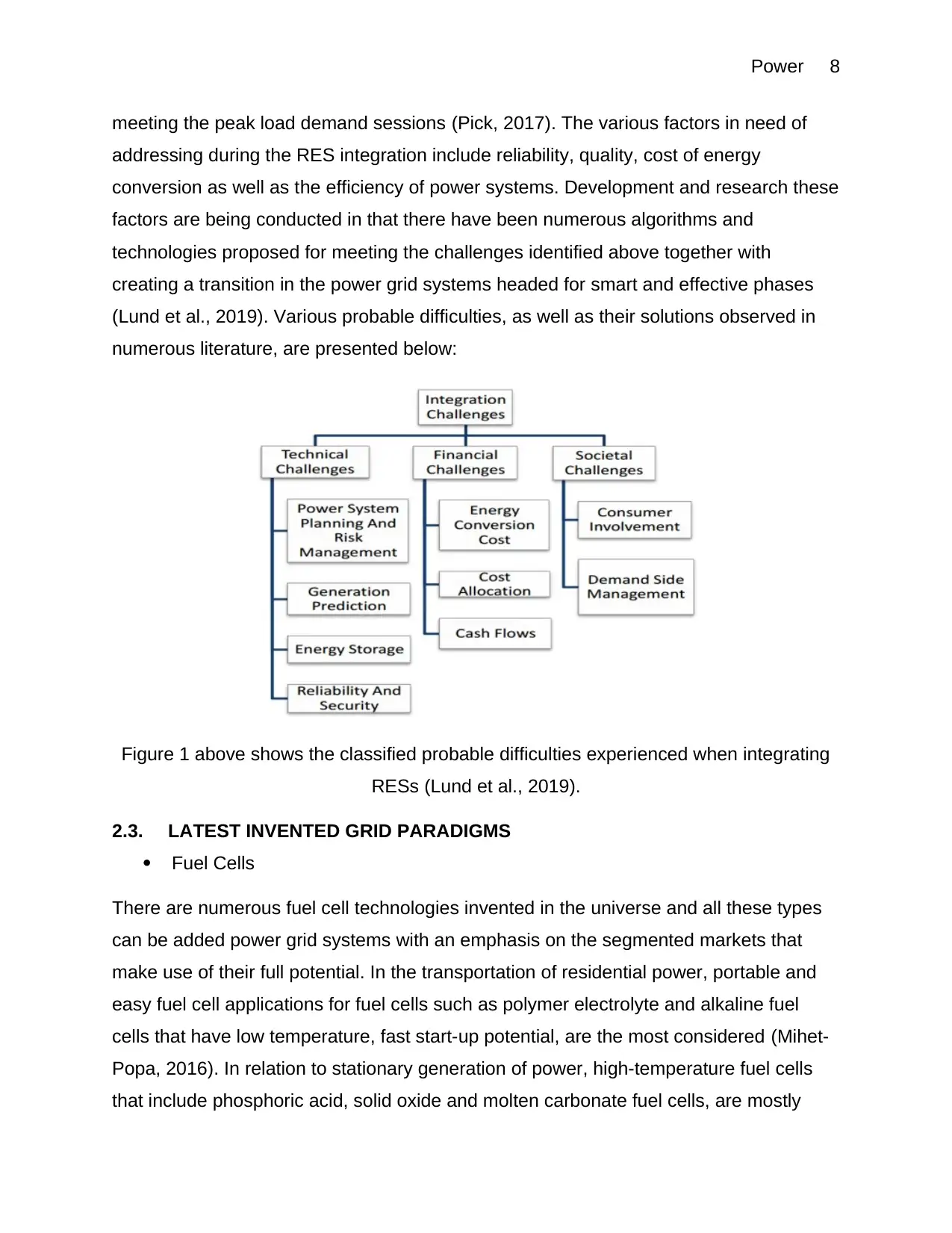
Power 8
meeting the peak load demand sessions (Pick, 2017). The various factors in need of
addressing during the RES integration include reliability, quality, cost of energy
conversion as well as the efficiency of power systems. Development and research these
factors are being conducted in that there have been numerous algorithms and
technologies proposed for meeting the challenges identified above together with
creating a transition in the power grid systems headed for smart and effective phases
(Lund et al., 2019). Various probable difficulties, as well as their solutions observed in
numerous literature, are presented below:
Figure 1 above shows the classified probable difficulties experienced when integrating
RESs (Lund et al., 2019).
2.3. LATEST INVENTED GRID PARADIGMS
Fuel Cells
There are numerous fuel cell technologies invented in the universe and all these types
can be added power grid systems with an emphasis on the segmented markets that
make use of their full potential. In the transportation of residential power, portable and
easy fuel cell applications for fuel cells such as polymer electrolyte and alkaline fuel
cells that have low temperature, fast start-up potential, are the most considered (Mihet-
Popa, 2016). In relation to stationary generation of power, high-temperature fuel cells
that include phosphoric acid, solid oxide and molten carbonate fuel cells, are mostly
meeting the peak load demand sessions (Pick, 2017). The various factors in need of
addressing during the RES integration include reliability, quality, cost of energy
conversion as well as the efficiency of power systems. Development and research these
factors are being conducted in that there have been numerous algorithms and
technologies proposed for meeting the challenges identified above together with
creating a transition in the power grid systems headed for smart and effective phases
(Lund et al., 2019). Various probable difficulties, as well as their solutions observed in
numerous literature, are presented below:
Figure 1 above shows the classified probable difficulties experienced when integrating
RESs (Lund et al., 2019).
2.3. LATEST INVENTED GRID PARADIGMS
Fuel Cells
There are numerous fuel cell technologies invented in the universe and all these types
can be added power grid systems with an emphasis on the segmented markets that
make use of their full potential. In the transportation of residential power, portable and
easy fuel cell applications for fuel cells such as polymer electrolyte and alkaline fuel
cells that have low temperature, fast start-up potential, are the most considered (Mihet-
Popa, 2016). In relation to stationary generation of power, high-temperature fuel cells
that include phosphoric acid, solid oxide and molten carbonate fuel cells, are mostly
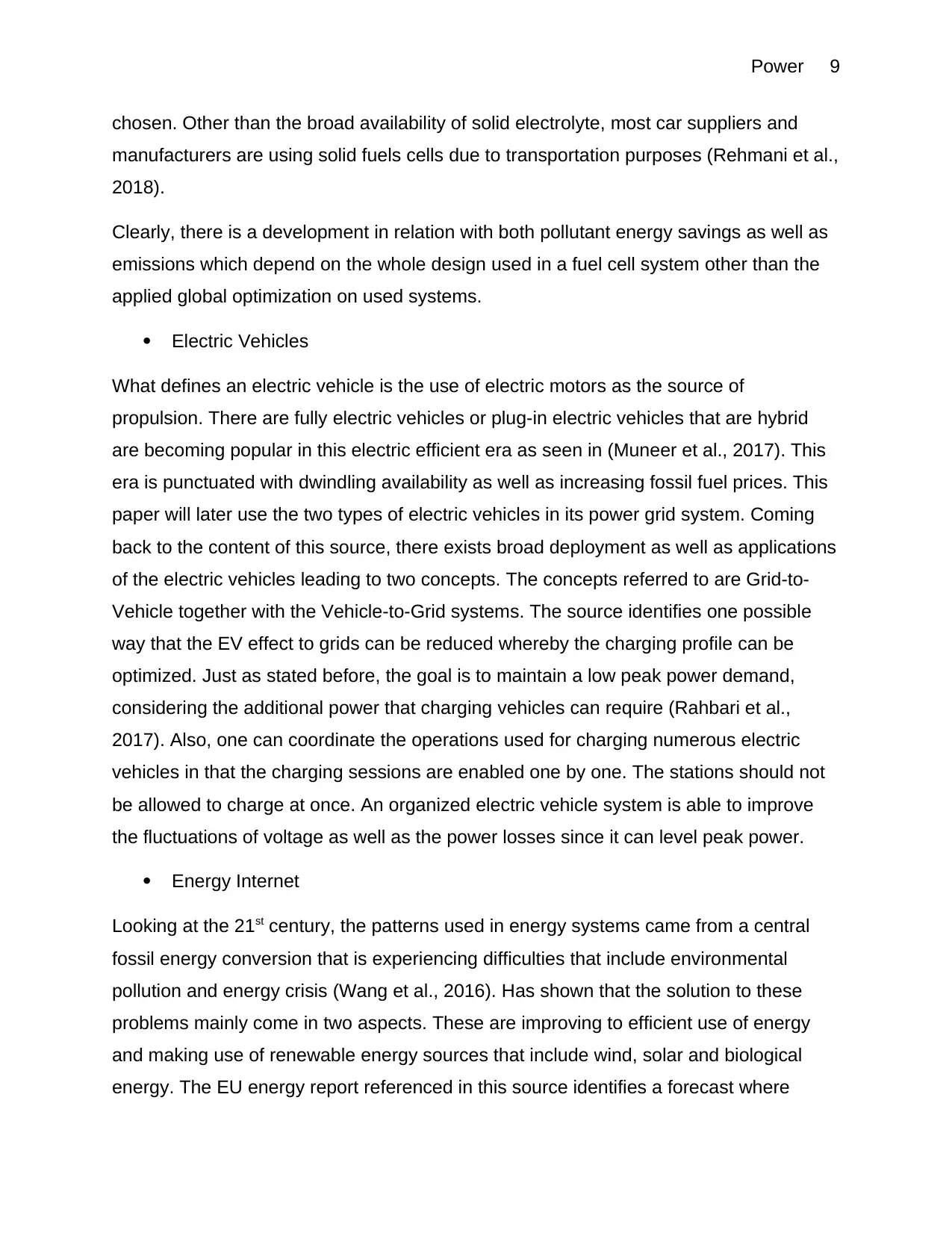
Power 9
chosen. Other than the broad availability of solid electrolyte, most car suppliers and
manufacturers are using solid fuels cells due to transportation purposes (Rehmani et al.,
2018).
Clearly, there is a development in relation with both pollutant energy savings as well as
emissions which depend on the whole design used in a fuel cell system other than the
applied global optimization on used systems.
Electric Vehicles
What defines an electric vehicle is the use of electric motors as the source of
propulsion. There are fully electric vehicles or plug-in electric vehicles that are hybrid
are becoming popular in this electric efficient era as seen in (Muneer et al., 2017). This
era is punctuated with dwindling availability as well as increasing fossil fuel prices. This
paper will later use the two types of electric vehicles in its power grid system. Coming
back to the content of this source, there exists broad deployment as well as applications
of the electric vehicles leading to two concepts. The concepts referred to are Grid-to-
Vehicle together with the Vehicle-to-Grid systems. The source identifies one possible
way that the EV effect to grids can be reduced whereby the charging profile can be
optimized. Just as stated before, the goal is to maintain a low peak power demand,
considering the additional power that charging vehicles can require (Rahbari et al.,
2017). Also, one can coordinate the operations used for charging numerous electric
vehicles in that the charging sessions are enabled one by one. The stations should not
be allowed to charge at once. An organized electric vehicle system is able to improve
the fluctuations of voltage as well as the power losses since it can level peak power.
Energy Internet
Looking at the 21st century, the patterns used in energy systems came from a central
fossil energy conversion that is experiencing difficulties that include environmental
pollution and energy crisis (Wang et al., 2016). Has shown that the solution to these
problems mainly come in two aspects. These are improving to efficient use of energy
and making use of renewable energy sources that include wind, solar and biological
energy. The EU energy report referenced in this source identifies a forecast where
chosen. Other than the broad availability of solid electrolyte, most car suppliers and
manufacturers are using solid fuels cells due to transportation purposes (Rehmani et al.,
2018).
Clearly, there is a development in relation with both pollutant energy savings as well as
emissions which depend on the whole design used in a fuel cell system other than the
applied global optimization on used systems.
Electric Vehicles
What defines an electric vehicle is the use of electric motors as the source of
propulsion. There are fully electric vehicles or plug-in electric vehicles that are hybrid
are becoming popular in this electric efficient era as seen in (Muneer et al., 2017). This
era is punctuated with dwindling availability as well as increasing fossil fuel prices. This
paper will later use the two types of electric vehicles in its power grid system. Coming
back to the content of this source, there exists broad deployment as well as applications
of the electric vehicles leading to two concepts. The concepts referred to are Grid-to-
Vehicle together with the Vehicle-to-Grid systems. The source identifies one possible
way that the EV effect to grids can be reduced whereby the charging profile can be
optimized. Just as stated before, the goal is to maintain a low peak power demand,
considering the additional power that charging vehicles can require (Rahbari et al.,
2017). Also, one can coordinate the operations used for charging numerous electric
vehicles in that the charging sessions are enabled one by one. The stations should not
be allowed to charge at once. An organized electric vehicle system is able to improve
the fluctuations of voltage as well as the power losses since it can level peak power.
Energy Internet
Looking at the 21st century, the patterns used in energy systems came from a central
fossil energy conversion that is experiencing difficulties that include environmental
pollution and energy crisis (Wang et al., 2016). Has shown that the solution to these
problems mainly come in two aspects. These are improving to efficient use of energy
and making use of renewable energy sources that include wind, solar and biological
energy. The EU energy report referenced in this source identifies a forecast where
⊘ This is a preview!⊘
Do you want full access?
Subscribe today to unlock all pages.

Trusted by 1+ million students worldwide
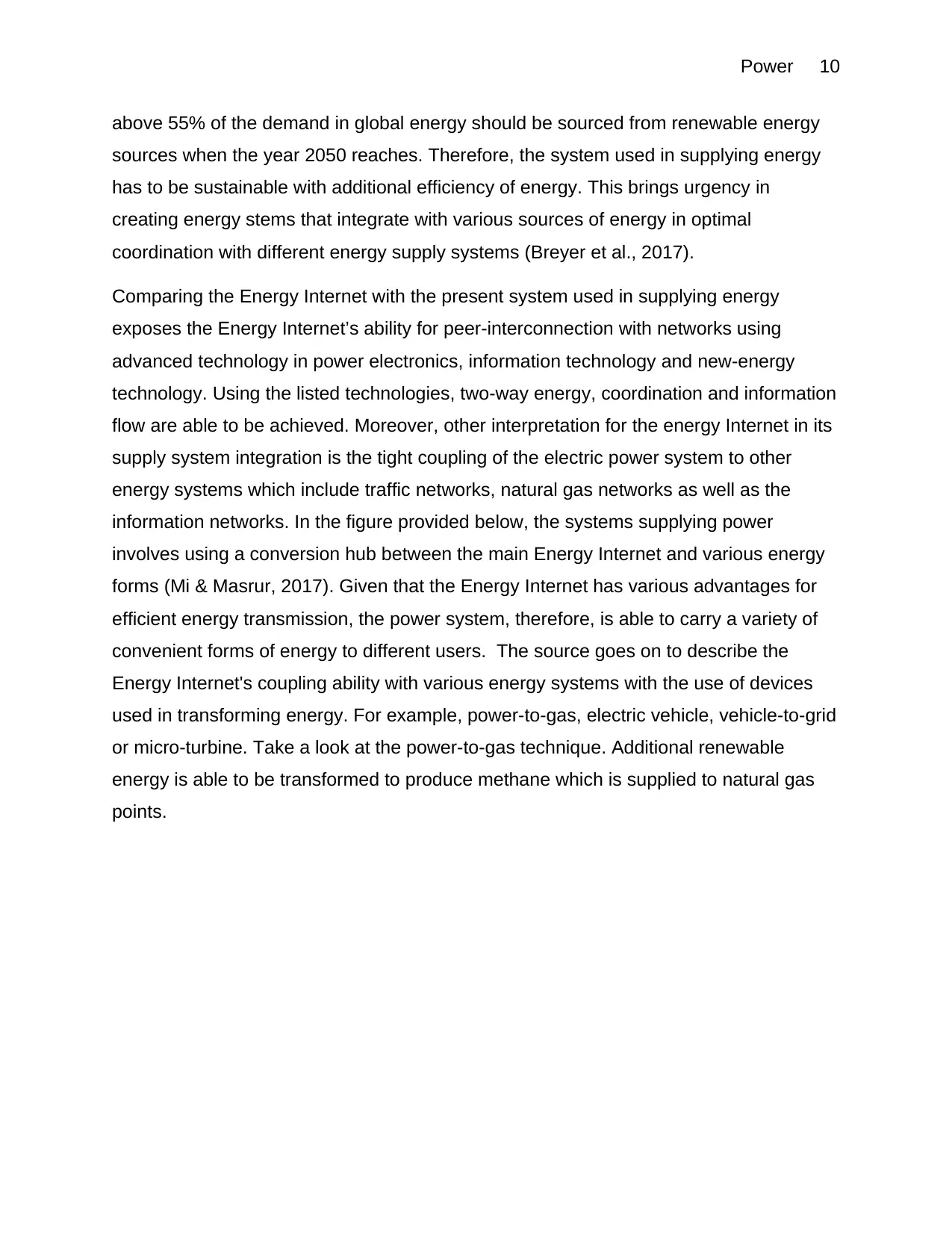
Power 10
above 55% of the demand in global energy should be sourced from renewable energy
sources when the year 2050 reaches. Therefore, the system used in supplying energy
has to be sustainable with additional efficiency of energy. This brings urgency in
creating energy stems that integrate with various sources of energy in optimal
coordination with different energy supply systems (Breyer et al., 2017).
Comparing the Energy Internet with the present system used in supplying energy
exposes the Energy Internet’s ability for peer-interconnection with networks using
advanced technology in power electronics, information technology and new-energy
technology. Using the listed technologies, two-way energy, coordination and information
flow are able to be achieved. Moreover, other interpretation for the energy Internet in its
supply system integration is the tight coupling of the electric power system to other
energy systems which include traffic networks, natural gas networks as well as the
information networks. In the figure provided below, the systems supplying power
involves using a conversion hub between the main Energy Internet and various energy
forms (Mi & Masrur, 2017). Given that the Energy Internet has various advantages for
efficient energy transmission, the power system, therefore, is able to carry a variety of
convenient forms of energy to different users. The source goes on to describe the
Energy Internet's coupling ability with various energy systems with the use of devices
used in transforming energy. For example, power-to-gas, electric vehicle, vehicle-to-grid
or micro-turbine. Take a look at the power-to-gas technique. Additional renewable
energy is able to be transformed to produce methane which is supplied to natural gas
points.
above 55% of the demand in global energy should be sourced from renewable energy
sources when the year 2050 reaches. Therefore, the system used in supplying energy
has to be sustainable with additional efficiency of energy. This brings urgency in
creating energy stems that integrate with various sources of energy in optimal
coordination with different energy supply systems (Breyer et al., 2017).
Comparing the Energy Internet with the present system used in supplying energy
exposes the Energy Internet’s ability for peer-interconnection with networks using
advanced technology in power electronics, information technology and new-energy
technology. Using the listed technologies, two-way energy, coordination and information
flow are able to be achieved. Moreover, other interpretation for the energy Internet in its
supply system integration is the tight coupling of the electric power system to other
energy systems which include traffic networks, natural gas networks as well as the
information networks. In the figure provided below, the systems supplying power
involves using a conversion hub between the main Energy Internet and various energy
forms (Mi & Masrur, 2017). Given that the Energy Internet has various advantages for
efficient energy transmission, the power system, therefore, is able to carry a variety of
convenient forms of energy to different users. The source goes on to describe the
Energy Internet's coupling ability with various energy systems with the use of devices
used in transforming energy. For example, power-to-gas, electric vehicle, vehicle-to-grid
or micro-turbine. Take a look at the power-to-gas technique. Additional renewable
energy is able to be transformed to produce methane which is supplied to natural gas
points.
Paraphrase This Document
Need a fresh take? Get an instant paraphrase of this document with our AI Paraphraser
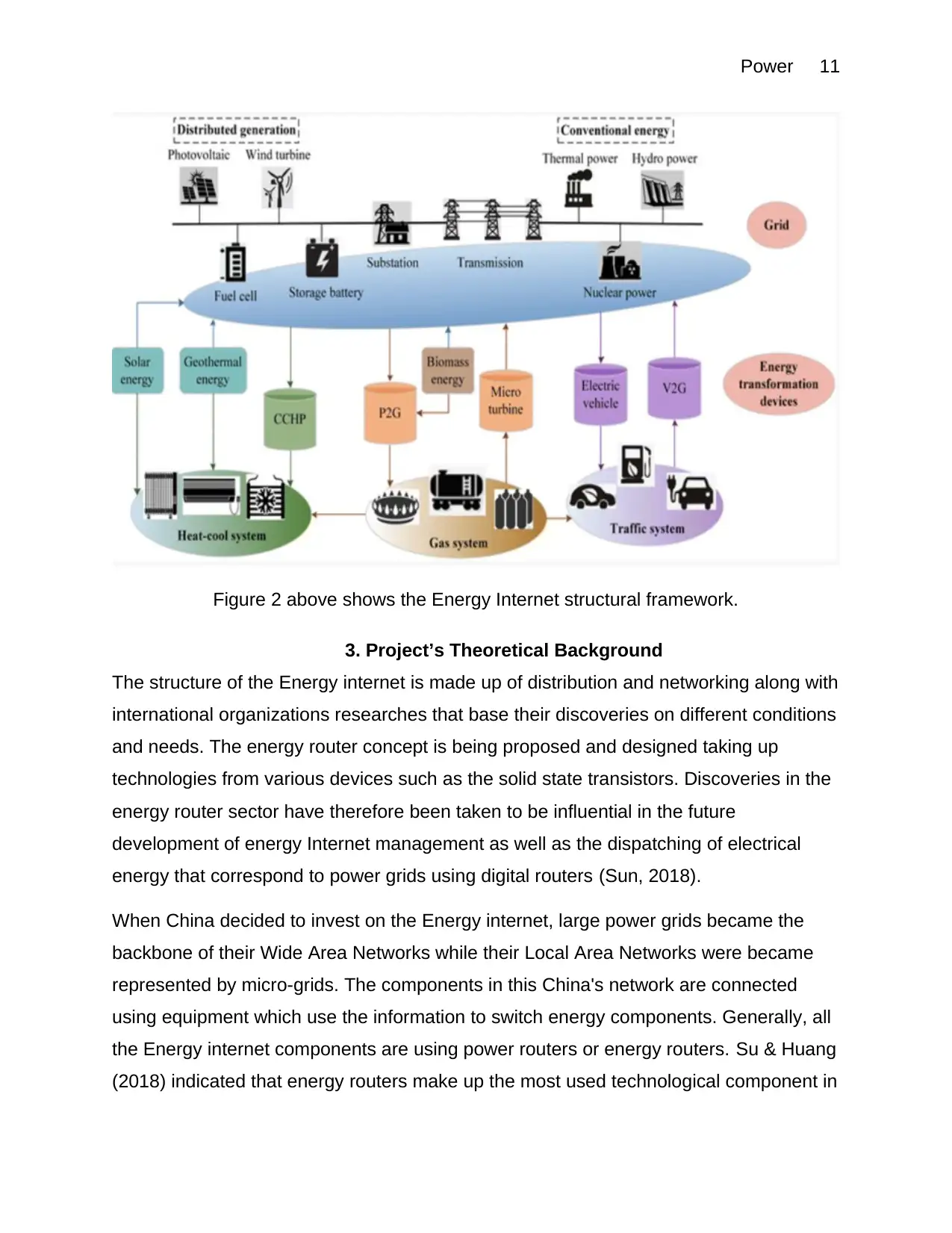
Power 11
Figure 2 above shows the Energy Internet structural framework.
3. Project’s Theoretical Background
The structure of the Energy internet is made up of distribution and networking along with
international organizations researches that base their discoveries on different conditions
and needs. The energy router concept is being proposed and designed taking up
technologies from various devices such as the solid state transistors. Discoveries in the
energy router sector have therefore been taken to be influential in the future
development of energy Internet management as well as the dispatching of electrical
energy that correspond to power grids using digital routers (Sun, 2018).
When China decided to invest on the Energy internet, large power grids became the
backbone of their Wide Area Networks while their Local Area Networks were became
represented by micro-grids. The components in this China's network are connected
using equipment which use the information to switch energy components. Generally, all
the Energy internet components are using power routers or energy routers. Su & Huang
(2018) indicated that energy routers make up the most used technological component in
Figure 2 above shows the Energy Internet structural framework.
3. Project’s Theoretical Background
The structure of the Energy internet is made up of distribution and networking along with
international organizations researches that base their discoveries on different conditions
and needs. The energy router concept is being proposed and designed taking up
technologies from various devices such as the solid state transistors. Discoveries in the
energy router sector have therefore been taken to be influential in the future
development of energy Internet management as well as the dispatching of electrical
energy that correspond to power grids using digital routers (Sun, 2018).
When China decided to invest on the Energy internet, large power grids became the
backbone of their Wide Area Networks while their Local Area Networks were became
represented by micro-grids. The components in this China's network are connected
using equipment which use the information to switch energy components. Generally, all
the Energy internet components are using power routers or energy routers. Su & Huang
(2018) indicated that energy routers make up the most used technological component in
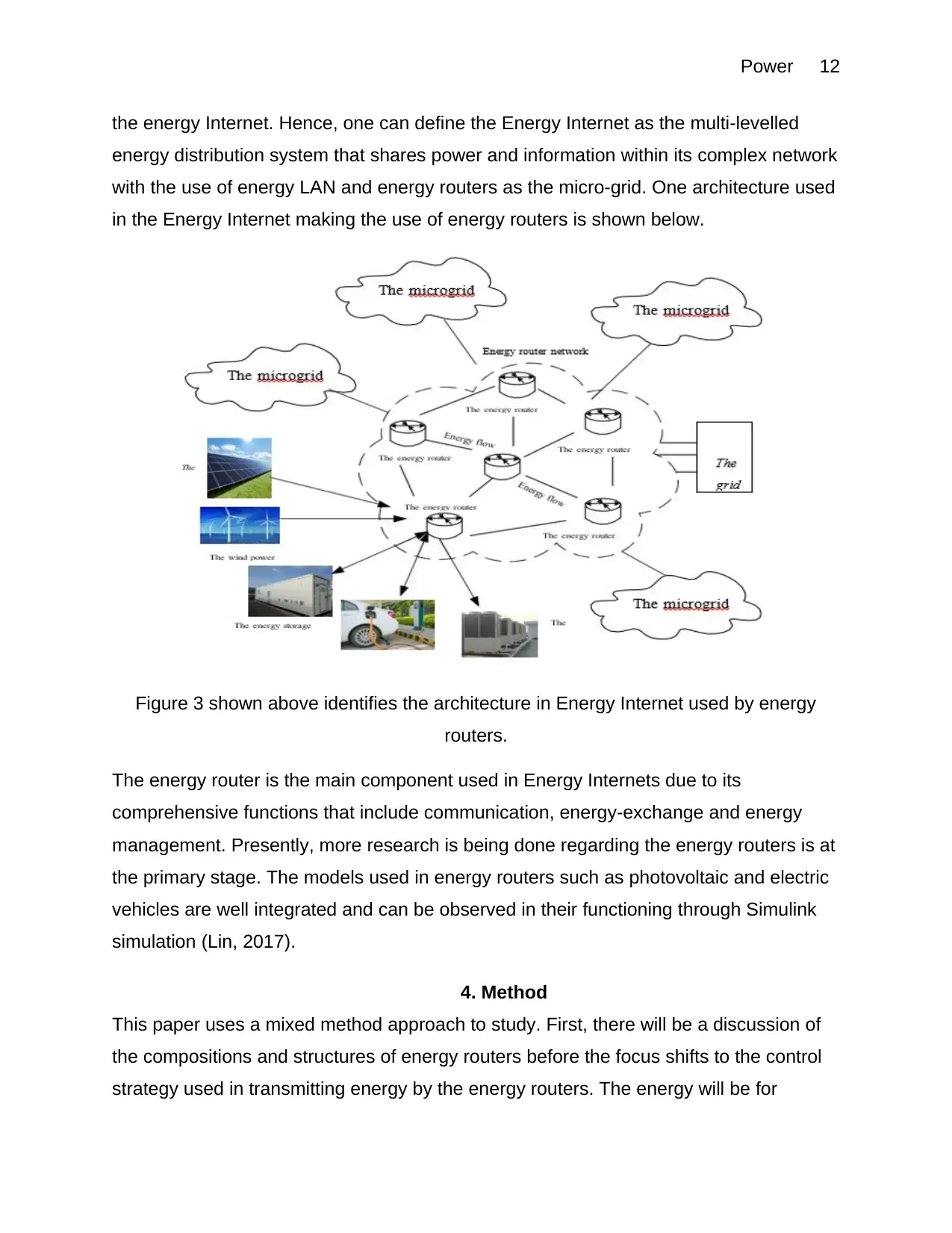
Power 12
the energy Internet. Hence, one can define the Energy Internet as the multi-levelled
energy distribution system that shares power and information within its complex network
with the use of energy LAN and energy routers as the micro-grid. One architecture used
in the Energy Internet making the use of energy routers is shown below.
Figure 3 shown above identifies the architecture in Energy Internet used by energy
routers.
The energy router is the main component used in Energy Internets due to its
comprehensive functions that include communication, energy-exchange and energy
management. Presently, more research is being done regarding the energy routers is at
the primary stage. The models used in energy routers such as photovoltaic and electric
vehicles are well integrated and can be observed in their functioning through Simulink
simulation (Lin, 2017).
4. Method
This paper uses a mixed method approach to study. First, there will be a discussion of
the compositions and structures of energy routers before the focus shifts to the control
strategy used in transmitting energy by the energy routers. The energy will be for
the energy Internet. Hence, one can define the Energy Internet as the multi-levelled
energy distribution system that shares power and information within its complex network
with the use of energy LAN and energy routers as the micro-grid. One architecture used
in the Energy Internet making the use of energy routers is shown below.
Figure 3 shown above identifies the architecture in Energy Internet used by energy
routers.
The energy router is the main component used in Energy Internets due to its
comprehensive functions that include communication, energy-exchange and energy
management. Presently, more research is being done regarding the energy routers is at
the primary stage. The models used in energy routers such as photovoltaic and electric
vehicles are well integrated and can be observed in their functioning through Simulink
simulation (Lin, 2017).
4. Method
This paper uses a mixed method approach to study. First, there will be a discussion of
the compositions and structures of energy routers before the focus shifts to the control
strategy used in transmitting energy by the energy routers. The energy will be for
⊘ This is a preview!⊘
Do you want full access?
Subscribe today to unlock all pages.

Trusted by 1+ million students worldwide
1 out of 37
Related Documents
Your All-in-One AI-Powered Toolkit for Academic Success.
+13062052269
info@desklib.com
Available 24*7 on WhatsApp / Email
![[object Object]](/_next/static/media/star-bottom.7253800d.svg)
Unlock your academic potential
Copyright © 2020–2025 A2Z Services. All Rights Reserved. Developed and managed by ZUCOL.



